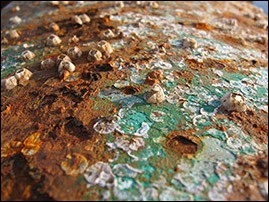Corrosion, a destructive and costly natural phenomenon, significantly impacts various aspects of modern life, from infrastructure integrity to the longevity of everyday objects. Understanding the science behind corrosion is crucial for developing effective prevention and mitigation strategies.
 Corrosion on a metal surface
Corrosion on a metal surface
The Detrimental Impact of Corrosion
Corrosion poses a substantial threat, leading to the collapse of structures, pipeline failures, chemical leaks, and even domestic issues like flooding. Beyond structural damage, corroded electrical components can trigger fires, while corrosion in medical implants can result in severe health complications. The impact extends to cultural heritage, with air pollution-induced corrosion damaging invaluable works of art. Furthermore, corrosion presents challenges in the safe long-term storage of radioactive waste.
Electrochemical Reactions and Corrosion
Many forms of corrosion are rooted in electrochemical reactions. General corrosion occurs when most or all atoms on a metal surface oxidize, leading to widespread damage. Most metals readily oxidize when exposed to oxygen or water. The metal loses electrons to oxygen (or other substances), causing the oxygen to be reduced (gain electrons), forming an oxide.
Galvanic corrosion arises when dissimilar metals are in contact within an electrolyte. The more active metal corrodes preferentially. Electrolytic corrosion, prevalent in electronic devices, occurs when moisture becomes trapped between electrical contacts with an applied voltage, creating an unintended electrolytic cell.
Consider the Statue of Liberty. Despite its imposing appearance, it is susceptible to corrosion. While the greenish patina on its copper skin provides some protection, internal corrosion has caused significant damage over time. The statue’s iron frame and copper skin acted as electrodes in a massive galvanic cell, resulting in the substantial rusting of the frame by its centennial in 1986.
Natural Passivity and Protection Against Corrosion
Some metals exhibit natural passivity, resisting corrosion due to the formation of a thin oxide film when exposed to air. This film acts as a barrier, preventing further reaction. The patina on copper and the weathering of certain sculpture materials are examples of this protective mechanism. However, this protection can fail if the film is damaged by stress or abrasion. While repassivation may occur, localized corrosion can result if it doesn’t, leading to concentrated damage.
Preventing Harmful Corrosion
Various methods can prevent harmful corrosion. Applying electrical currents can induce passive film formation on metals that don’t naturally possess them. Selecting metals that are more stable in specific environments is another approach. Scientists have developed alloys like stainless steel to enhance performance in challenging conditions. Laser treatments can create non-crystalline structures that resist corrosion. Galvanization involves coating iron or steel with zinc, creating a galvanic cell where the zinc corrodes instead of the iron. Electroplating with inert or passivating metals offers protection. Non-metallic coatings like plastics, paints, and oils are also effective corrosion barriers.
By understanding the causes and implementing appropriate prevention techniques, the detrimental effects of corrosion can be minimized, extending the lifespan and ensuring the safety of structures and systems.

